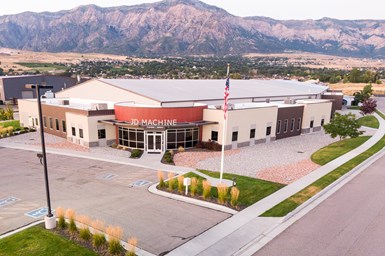JD Machine’s new facility offers the modern, inviting look the company had hoped it would. Source: JD Machine
My story here wraps up describing the how’s and why’s of Odgen, Utah’s JD Machine investing in a larger facility and working with an architect to create a fresh, new and inviting look for the building’s façade, lobby and office areas.
“Our previous building was fairly boring and not at all stylish,” says Matt Wardle, president of contract manufacturer JD Machine. “We wanted the new one to look more appealing, including an open lobby with ample windows to bring in abundant natural light. The feeling was all of this complements the nature of the high-tech industries we serve while providing a more attractive look for potential new hires.”
This is representative of a trend I’ve noticed over my 20 years traveling and writing for Gardner Business Media brands Production Machining and Modern Machine Shop. That is, machine shops investing to make their facilities present a more modern look compared to the bland, unappealing and dirty factories of yesteryear. Troy Anderson, a project architect for 28 years, agrees.
Anderson, who at the time worked for Dixon and Associates, was the architect to lead this project for JD Machine. He has experience designing space for retail, office, hospitality, warehousing, fitness centers, automotive dealerships and other fields.
During his 25 years with Dixon and Associates, he was trained to approach projects with a developer’s mindset, aiming to design the most cost-effective building he could while concentrating on generating the most “bang for the buck” at the customer entrance. He applies that same approach now with his own company, Clarity Design Group, which he launched a few years ago.
“I suggest to clients spending money where it matters the most for the employee and their productivity while projecting what they want the building to represent to employees, visitors and the community,” he explains. “That it’s a place of repute representative of a company that values design and its image.”
This includes considerations for parking (public and private), traffic flow and the like. It’s not dissimilar to designing efficient product and workflow in the manufacturing area. What will visitors see when they first arrive? How are they welcomed into the building? What does that experience look like?
As shown in the photo, Anderson incorporated stylish corrugated metal and a steel trellis in the creation of the radiused entrance at the corner of JD Machine’s main production building. This was intentional so as not to turn one’s back to the industrial nature of what the shop is all about, but rather to complement it using appropriate materials in a stylistic, welcoming way.
For the foyer and offices, which are saddle-bagged around the production building, it was important to maximize the amount of natural light with large windows to make sure those spaces are bright and hospitable. To Wardle, this was important. But what also was important was to provide visitors gathered in the shop’s new conference room with a clear view of the manufacturing area given the pride he had in the shop’s cleanliness and organization, not to mention the advanced technology his shop leverages to its advantage.
Anderson cites differences working on developer projects such as retail stores compared to a more one-off project such as JD Machine’s. “With Matt, he’s the owner/operator; this is his place,” he explains. “This was a significant investment and a unique, one-and-done project sans the expansions that happened afterwards. He was and should be very much invested in the details and I appreciate that.
“I’ve heard it said that the best architect is one where when the projects are complete, the owners think they designed the entire building themselves,” Anderson says. “That’s what I aim for.”
Read Next
Emerging Leaders Nominations Now Open
Here’s your chance to highlight a young person in your manufacturing business who is on the path to be a future leader moving your company forward.
Read MoreA Tooling Workshop Worth a Visit
Marubeni Citizen-Cincom’s tooling and accessory workshop offers a chance to learn more about ancillary devices that can boost machining efficiency and capability.
Read More5 Aspects of PMTS I Appreciate
The three-day edition of the 2025 Precision Machining Technology Show kicks off at the start of April. I’ll be there, and here are some reasons why.
Read More




















